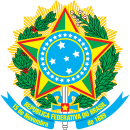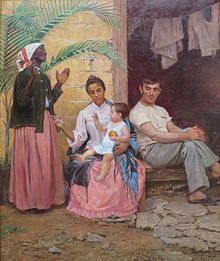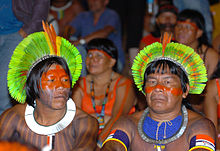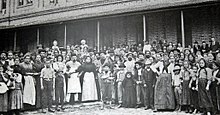Race and ethnicity in Brazil
[5] In the late 19th and early 20th centuries, in what is known as Great Immigration,[6] new groups arrived, mainly of Portuguese, Italian, Spanish and German origin, but also from Japan, the Middle East, and Eastern Europe.[8] When it became clear that this policy would result in the land being taken by other European powers, namely the French and the Dutch, the Portuguese Crown decided to effectively occupy the territory by fostering agricultural activities, especially sugarcane crops, in Brazil.On October 23, in São Paulo, for instance, there were violent confrontations between the police and rioting Blacks, who chanted "long live freedom" and "death to the slaveowners".[26]: 74 Uprisings erupted in Itu, Campinas, Indaiatuba, Amparo, Piracicaba and Capivari; ten thousand fugitive slaves grouped in Santos.It was as a response to such events that, on May 13, 1888, slavery was abolished, as a means to restore order and the control of the ruling class,[26]: 76 in a situation in which the slave system was almost completely disorganised[citation needed]."[29] In 1878, ten years before the abolition of slavery, Rio de Janeiro hosted the Congresso Agrícola (Agricultural Congress) and that meeting reflected what the Brazilian elite (especially coffee planters) expected from their future workers.Although discussions were situated in a theoretical field, immigrants arrived and colonies were founded through all this period (the rule of Pedro II), especially from 1850 on, particularly in the Southeast and Southern Brazil.These discussions culminated in the Decree 528 in 1890, signed by Brazil's first President Deodoro da Fonseca, which opened the national harbors to immigration except for Africans and Asians.[33] As a result of those discussions and policies,[34] Brazil experienced immigration mostly from countries such as Portugal, Italy, Spain, Germany, France, Poland, Russia, Ukraine, etc., during the end of the empire and the beginning of the republic period (late 19th and early 20th centuries).The book appeared at a moment when there was a widespread belief among social scientists that some races were superior to other ones, and in the same period when the Nazi Party in Germany was on the rise.However, Freyre's book created the Brazilian myth of the Racial democracy, which held that Brazil was a "post-racial" country without identitarianism or desire to preserve one's European ancestry.He repeated several times that he did not create the myth of a racial democracy and that the fact that his books recognized the intense mixing between "races" in Brazil did not mean a lack of prejudice or discrimination.No one in Brazil would have thought of laws against interracial marriage ... Fraternal spirit is stronger among Brazilians than racial prejudice, colour, class or religion.[43] In 1809, when a provincial militia was formed in Rio Grande do Sul, it was established that the members should be "White", this being defined as "those whose great-grandparents were not Black, and whose parents were free-born".[44] On July 28, 1921, representatives Andrade Bezerra and Cincinato Braga proposed a law whose Article 1 provided: "It is prohibited in Brazil immigration of individuals from the black race."[47] This made possible a myth of "racial democracy" that tends to obscure a widespread discrimination connected to certain aspects of physical appearance:[48][49] aspects related to the concept of cor ("colour"), used in a way that is roughly equivalent to the English term "race" but based on a combination of skin colour, hair type, shape of nose and lips, and even clearly cultural phenomena such as neighborhood of residence, linguistic habits and class.[51] Nonetheless, and in conjunction with recent emphases on genetic testing, a variety of social movements, government programs, and academic and popular initiatives have led to an increasing emphasis on historicity and ancestry in racial identification in Brazil and this has tended to counteract what many commentators have long sought to characterize—perhaps incorrectly, perhaps correctly, as a Brazilian racial mutability or malleability.In the census, respondents choose their race or color in five categories: branca (white), parda (multiracial), preta (black), amarela (yellow) or indígena (indigenous).Others are clearly variations of the same idea (preto, negro, escuro, crioulo, retinto, for Black, alva, clara, cor-de-leite, galega, rosa, rosada, pálida, for White, parda, mulata, mestiça, mista, for "parda"), or precisions of the same concept (branca morena, branca clara), and can actually grouped together with one of the main racial terms without falsifying the interpretation.Derived from Latin maurus, meaning inhabitant of Mauritania,[73]: 14 traditionally it is used as a term to distinguish White people with dark hair, as opposed to "ruivo" (redhead) and "loiro" (blonde).[85] Genetic autosomal studies have shown the Brazilian population as a whole to have European, African and Native Americans components, presenting a triracial admixture pattern.A study from 2009 analyzed the information content of 28 ancestry-informative SNPs into multiplexed panels using three parental population sources (African, Amerindian, and European) to infer the genetic admixture in an urban sample of the five Brazilian geopolitical regions.[90] An autosomal DNA study from 2009 found a similar profile "all the Brazilian samples (regions) lie more closely to the European group than to the African populations or to the Mestiços".[89] A more recent 2024 study in São Paulo using representative samples collected in 2015 has found the following average genetic ancestry: 71.5% European, 18.2% African and 6.1% Native American.The high ancestral variability observed in Whites and Blacks suggests that each Brazilian has a singular and quite individual proportion of European, African and Amerindian ancestry in his/her mosaic genomes.[112] Notably, the first half of the 20th century saw a large inflow of Japanese (mainly from Honshū, Hokkaidō and Okinawa) and Arabic-speaking Levantine Christians (from modern day Lebanon and Syria) immigrants.Nevertheless, in the following years, a further 4,830 Germans arrived at São Leopoldo, and then the colony started to develop, with the immigrants establishing the town of Novo Hamburgo (New Hamburg).[123] From São Leopoldo and Novo Hamburgo, the German immigrants spread into others areas of Rio Grande do Sul, mainly close to sources of rivers.The State of Paraná received the majority of Polish immigrants, who settled mainly in the region of Curitiba, in the towns of Mallet, Cruz Machado, São Matheus do Sul, Irati, and União da Vitória.After independence and principally after 1850, Southeast Brazil was "inundated" by European immigrants, who were attracted by the government to replace the African slaves in the coffee plantations.



1st




2nd










3rd










4th





































Historical conceptsBiblical terminology for raceColor terminologyRace relationsRacializationRacismscientific racismRacial equalityRacial politicsSociology of raceUnited KingdomUnited StatesGeneticsHealthHorror filmsIntelligencehistoryNeuroscienceSexualitySocietySportsVideo gamesRace and ethnicity in censusesColombiaLatin AmericaColonialismNakedness and colonialismEthnic groupHuman skin colorSocial stratificationWhite supremacyCulture of BrazilDemographicsFolkloreHolidaysImmigrationLanguagesPeopleReligionsArchitectureCinemaComicsCuisineLiteratureTelevisionMonumentsPaintingVideo gamingCoat of armsAnthemMiss BrazilWorld Heritage SitesBrazilian societyIndigenousPortugueseAfricanItaliansSpaniardsGermansLebaneseJapaneseBrazilGermanItaliancafuzomulatocabocloNativeRio de JaneiroSão PauloWest AfricanYorubaAshantiGuaraniSpanishthe Middle EastEastern EuropeslaveryGaúchosPampasDutch Brazilimmigration to BrazilMiddle EasternsLebanonUkrainians1872 censusWhitesSlavery in BrazillatifundiariesPrinetti DecreeJapanese immigrationEuropeanLevantineRedemption of HamModesto BrocosMuseu Nacional de Belas Artesquadroonhypergamyracial whiteningPedro IISoutheastSouthern BrazilDeodoro da FonsecaEuropeMiddle EastPortugalGermanyFrancePolandRussiaUkraineOliveira Viannawhite BraziliansGermanicCelticIberianGilberto FreyreCasa-Grande & SenzalaNazi PartyRacial democracyUkrainianCuritibaracial segregationOld SouthBrazilian CongressPardo Brazilian
